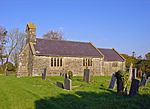Cilgerran

Cilgerran (previously Kilgerran or Cil-Garon) is both a village, a parish, and also a community, situated on the south bank of the River Teifi in Pembrokeshire, Wales. It was formerly an incorporated market town. Among Cilgerran's attractions are Cilgerran Castle and annual coracle races. Kilgerran Halt was a stop on the former Whitland and Cardigan Railway. There are a number of listed buildings, including the parish church. Nearby are the hamlets of Llwyncelyn, Rhoshill, Cnwce, Pen-y-bryn, Carreg-wen and Pontrhydyceirt, and the villages of Llechryd and Boncath. Cilgerran Hundred derives its title from the former town, which was once the headquarters of the commote of Emlyn is Cuch (Emlyn below the River Cych). Slate quarrying was an important activity in the 19th century.
Excerpt from the Wikipedia article Cilgerran (License: CC BY-SA 3.0, Authors, Images).Cilgerran
Llon Cardi Bach,
Geographical coordinates (GPS) Address Nearby Places Show on map
Geographical coordinates (GPS)
| Latitude | Longitude |
|---|---|
| N 52.05322 ° | E -4.63396 ° |
Address
Llon Cardi Bach
SA43 2TF , Cilgerran
Wales, United Kingdom
Open on Google Maps







